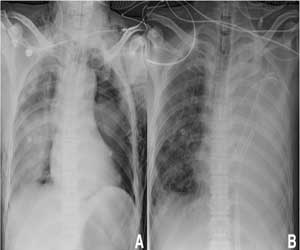- Home
- Editorial
- News
- Practice Guidelines
- Anesthesiology Guidelines
- Cancer Guidelines
- Cardiac Sciences Guidelines
- Critical Care Guidelines
- Dentistry Guidelines
- Dermatology Guidelines
- Diabetes and Endo Guidelines
- Diagnostics Guidelines
- ENT Guidelines
- Featured Practice Guidelines
- Gastroenterology Guidelines
- Geriatrics Guidelines
- Medicine Guidelines
- Nephrology Guidelines
- Neurosciences Guidelines
- Obs and Gynae Guidelines
- Ophthalmology Guidelines
- Orthopaedics Guidelines
- Paediatrics Guidelines
- Psychiatry Guidelines
- Pulmonology Guidelines
- Radiology Guidelines
- Surgery Guidelines
- Urology Guidelines
Doctors save patient of bilateral traumatic wet lung after thoracic trauma

Dr Feng Yun Wang at Critical Care Medicine Department of The First People’s Hospital of Foshan, Shiwan, Chancheng, Foshan, China and colleagues have reported a case of Severe thoracic trauma resulting in bilateral traumatic wet lung. The case has appeared in the Journal of BMC Pulmonary Medicine.
Blunt traumatic thoracic injuries are often seen in traffic accidents. Unlike usual injuries such as lung contusions, pneumothorax and rib fractures, tracheal ruptures or main bronchial ruptures are uncommon. Taken together the analysis of clinical manifestation, bronchoscopy and computed tomography (CT) scan, the diagnosis usually isn’t difficult to make. After double-lumen intubation and one-lung ventilation (OLV), in the absence of any surgical contraindication, the repair can be performed in most cases. Severe lung contusions or traumatic wet lung are the common causes of acute respiratory distress syndrome (ARDS).
Double lumen intubation and one-lung ventilation should be applied without delay in cases of traumatic main bronchial rupture. In most cases, when the patients’ vital signs have been stabilized, the repair can be performed. However, when one-lung ventilation is complicated by traumatic wet lung, the mortality rate is likely to be much higher.
In this case, the patient experienced a left main bronchial rupture, bilateral traumatic wet lung, and acute respiratory distress syndrome (ARDS) because of severe thoracic trauma. Though the patient was treated with intubation and mechanical ventilation (MV), his oxygenation was still not stable.
Thus, veno-venous extracorporeal membrane oxygenation (V-V ECMO) was initiated; upon the improvement of oxygenation, the patient received an exploratory thoracotomy. Unfortunately, the rupture proved to be irreparable, resulting in a total left pneumonectomy.
As there was severe ARDS caused by trauma, ECMO and ultra-low tidal volume (VT) MV strategy (3 ml/kg) were utilized for lung protection post-op. ECMO was sustained up to the 10th day, and MV until the 20th day, post-operation. With the support of MV, ECMO and other comprehensive measures, the patient made a recovery.
Key takeaways:-
- V-V ECMO and ultra-low VT MV helped this thoracic trauma patient survive the lung oedema period and prevented ventilator-associated pneumonia (VAP).
- In extreme situations, with the support of ECMO, the tidal volume may be lowered to 3 ml/kg.
For more details click on the link: https://doi.org/10.1186/s12890-019-0790-1

Disclaimer: This site is primarily intended for healthcare professionals. Any content/information on this website does not replace the advice of medical and/or health professionals and should not be construed as medical/diagnostic advice/endorsement or prescription. Use of this site is subject to our terms of use, privacy policy, advertisement policy. © 2020 Minerva Medical Treatment Pvt Ltd